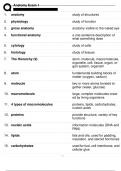Anatomy Exam 1
1. anatomy study of structures
2. physiology study of function
3. gross anatomy anatomy visible to the naked eye
4. functional anatomy a one sentence description of
what something does
5. cytology study of cells
6. histology study of tissues
7. The Hierarchy (9) atom, molecule, macromolecule,
organelle, cell, tissue, organ, or-
gan system, organism
8. atom fundamental building blocks of
matter (oxygen, carbon)
9. molecule two or more atoms bonded to-
gether (water, glucose)
10. macromolecule large, complex molecules creat-
ed by living organisms
11. 4 types of macromolecules proteins, lipids, carbohydrates,
nucleic acids
12. proteins provide structure, variety of key
functions
13. nucleic acids information molecules (DNA and
RNA)
14. lipids fats and oils, used for padding,
insulation, and steroid hormones
15. carbohydrates used for fuel, cell membrane, and
cellular glue
, Anatomy Exam 1
16. organelles highly organized structures with-
in cells
17. cells basic structural and functional
units of life, containers for chemi-
cal reactions.
18. tissue groups of cells in close proximity
to each other that work together
to carry out specialized activities
19. 4 major tissue types epithelial, connective, muscular,
nervous
20. organs two or more tissues working
together, forming recognizable
shapes and having specific func-
tions
21. organ systems (11) two or more organs working to-
gether to do a job
22. integumentary system (skin) protection from the environment,
environmental sensing, repair
23. skeletal support, protection, muscle at-
tachment for body movement,
mineral storage
24. muscular movement of body and sub-
stances in body, support of soft
tissues
25. nervous fast, immediate, point to point
communication and control,
thought/cognition
26. circulatory includes cardiovascular and lym-
phatic systems
cardiovascular transports nutri-
, Anatomy Exam 1
ents, wastes,
hormones
lymphatic is the site of most im-
mune system
functions
27. respiratory gas exchange, communication
28. digestive mechanical and chemical diges-
tion, absorption and ingestion
29. urinary filtration of blood to remove waste
30. reproductive make new people
31. endocrine slow, long term, body-wide com-
munication and control via hor-
mones in the bloodstream
32. immune protection from pathogens and
cancer, cleanup of old and dam-
aged cells
33. anterior toward front surface of body
34. posterior toward rear surface of body
35. ventral toward front surface of body
36. dorsal toward rear surface of body
37. superior toward head
38. inferior toward feet
39. lateral away from midline of body or or-
gan
40. medial toward midline of body or organ
41. proximal




